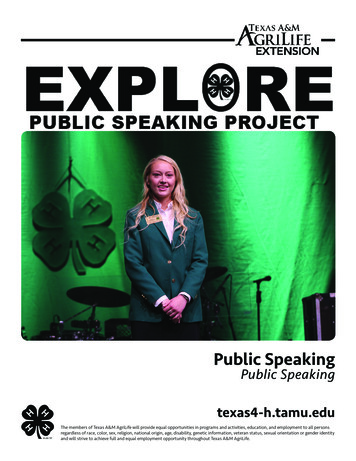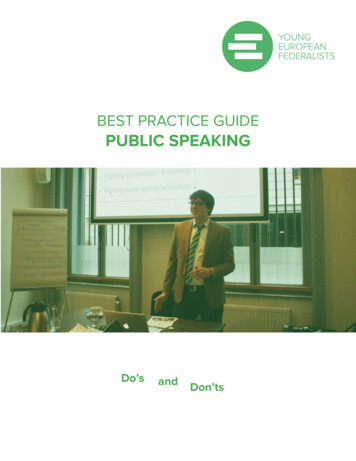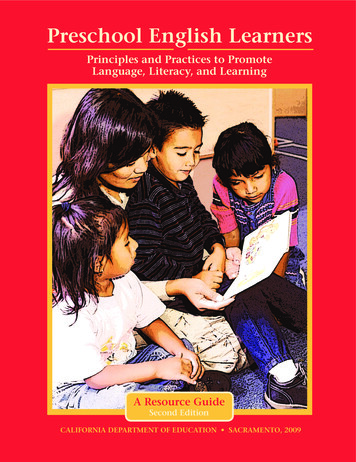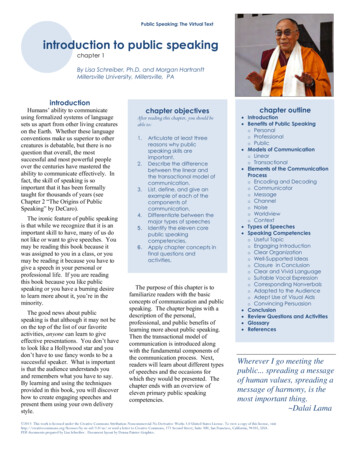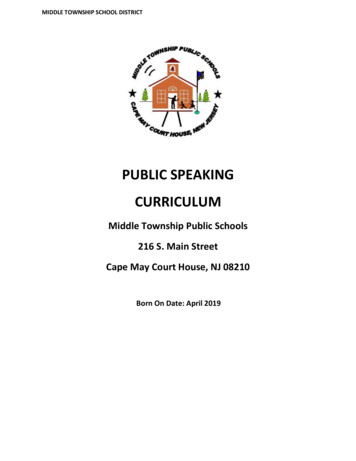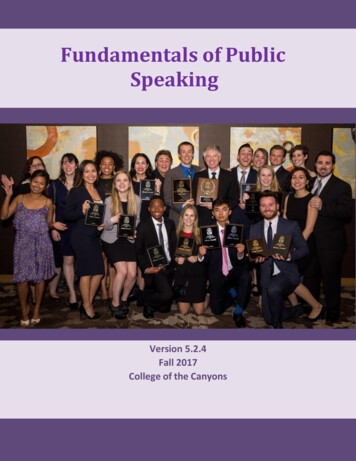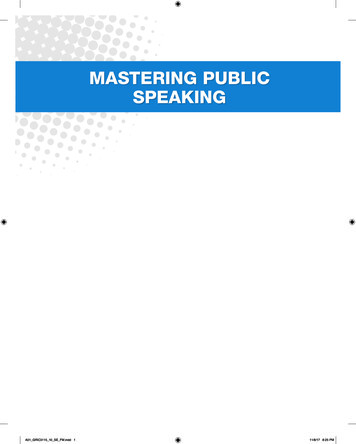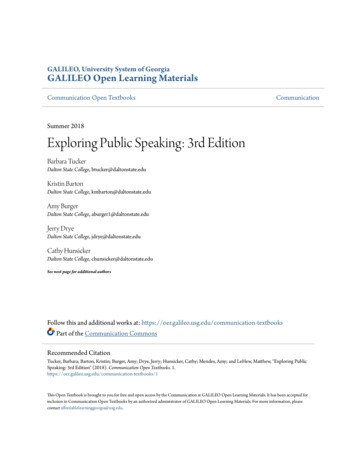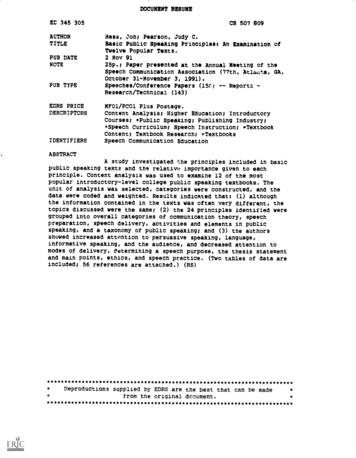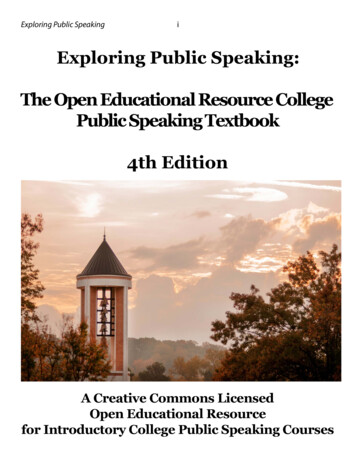
Transcription
Exploring Public SpeakingiExploring Public Speaking:The Open Educational Resource CollegePublic Speaking Textbook4th EditionA Creative Commons LicensedOpen Educational Resourcefor Introductory College Public Speaking Courses
Exploring Public SpeakingiiPrimary Author and Editor: Dr. Barbara G. TuckerContributors:Ms. Amy BurgerMr. Chad DanielMr. Jerry DryeMs. Cathy HunsickerMr. Matthew LeHewMs. Amy MendesConsultants:Mr. Nick CartyMs. Kim CorrellMs. Jackie DanielsMr. Zach Drye (graphics)Dr. Clint KinkeadDr. Sarah MinDr. Tami TomaselloDr. Marjorie YamborIn Memory of Dr. Kristin Barton, Originator of the Project and First EditorTextbook files available at http://exploringpublicspeaking.comFor questions regarding this textbook, contact:Dr. Barbara G. TuckerDepartment of CommunicationDalton State College650 College DriveDalton, GA 30720Lorberbaum Liberal Arts 107B(706) 272-4411btucker@daltonstate.edu
Exploring Public SpeakingiiiThis text exists under a Creative Commons Attribution-Noncommercial-ShareAlike 4.0 License, and as such it may be used for non-commercial purposes. Any portion of this text may be altered or edited; however,author attribution is required, and if you remix, transform, or build uponthe material, you must distribute your contributions under the same license as the original. Portions of this text were adapted from a free, opensource textbook without attribution as requested by the work’s originalcreator(s) and licensee(s). The authors of Exploring Public Speakingrequest that you let them know if you plan to use all or a major part of thistextbook as a primary text for your basic communication classes.Photographs are used by permission of the Office of Marketing and Communication at Dalton State College and are copyrighted 2019.
Exploring Public SpeakingivIntroduction to theFourth Edition ofExploring Public SpeakingExploring Public Speaking: The Open Educational Resource CollegePublic Speaking Textbook began as the brainchild of Dr. Kris Barton, former Chair of the Department of Communication at Dalton State College inDalton, Georgia. It also was made possible through a generous TextbookTransformation Grant in 2015 from Affordable Learning Georgia, a highlysuccessful program of the University System of Georgia. In applying for theoriginal grant, Dr. Barton asked me to help him author/compile the text.The original goal of our creation of Exploring Pubic Speaking was to provide a high-quality, usable, accessible, and low-cost textbook for the hundreds of students who take COMM 1110 at Dalton State College every year.This course is required of all degree-seeking students. We have alreadybeen able to save hundreds of thousands of dollars for students at our institution with this text.Dr. Barton and I worked on creating the textbook from July 2015 until May2016, with the goal of going live with the text in Summer of 2016. Tragically,Dr. Barton passed away in early May 2016. He has been greatly missed as afriend, colleague, father, scholar, teacher, and mentor.However, the launch of the book proceeded. In Summer 2017 I took on asignificant revision and update, which I named the Second Edition. In thatedition, I included information on college student success in the appendices for institutional reasons, and we have chosen to continue includingthose. In January 2018, colleague Matthew LeHew and I won a grant fromthe University System to create the ancillaries and improve the format formore accessibility. In April 2019, we were awarded another mini-grant tofurther revise the text and create a website for it. For this fourth edition, wehave removed “Dalton State” from the title and examples for wider appeal.An appendix on library research retains the information for specific use ofRoberts Library on our campus.We felt these changes were needed in the fourth edition because, unexpectedly and happily, the text has also been downloaded close to 40,000 timesfrom the GALILEO site as of August 2019 by readers all over the world, isused on six continents, and has been adopted at many other institutions.These institutions include state universities, well-known private universities, community and technical colleges, liberal arts colleges, and dual enrollment programs. Faculty users are welcome to submit their informationon the form at http://exploringpublicspeaking.com for access to the ancillaries.
Exploring Public SpeakingvOver 90% of the book is originally by Dr. Barton, me, or other colleagues atDalton State College. Some parts, specifically from Chapters 9, 10, and 15,are adapted from another open resource public speaking text whose authorprefers not to be cited.In Exploring Public Speaking, especially in its second through fourtheditions, we have attempted to create a usable, zero-cost textbook for basicpublic speaking courses or courses that include basic public speaking skillsas one of their primary learning outcomes. The free, open nature of the textmeans that instructors are able to use all or part of it, and add their ownmaterials.We believe this text addresses all the subjects that traditional publishers’books would address in an appropriate writing style and with appropriatecollege-level learning theory in mind. The appendices address some additional topics that might be excluded from most texts, but that we believeadd to the experience: learning theory, plagiarism, speaking online, speaking to diverse audiences, and humor in public speaking. In the third andfourth editions we have added “case study” examples and some differentoutline samples.We think this book is especially useful in coverage of PowerPoint, audienceanalysis and responsiveness, ethics in public speaking, persuasion, specialoccasion speeches, and structure of speeches. Because it was written bycommunication professors with decades of experience in the classroom, weare aware of the needs of basic public speaking students. Three ancillariesare currently available: electronic “flash cards” for study, PowerPoint slidedecks on the 15 main chapters, and test banks for the 15 main chapters. Asthe website is developed, it will include videos of student speeches.Two editorial notes: As per the American Collegiate Dictionary (2016), inmost cases we use the pronoun “they” when the antecedent is an indefinitepronoun, whether singular or plural, to avoid the awkward he/she/him/her/his/her combinations.Second, we admit to some redundancy in the textbook. Because it is anopen educational resource, some users do not access the whole text. Forclarity, sometimes a concept that is explained in a preceding chapter isre-explained.Thank you for downloading Exploring Public Speaking, and the co-authorsand I truly wish you happy teaching and learning with it. We welcomeinput. If you choose to use it, let us know at btucker@daltonstate.edu. Wekeep a database of those who contact us about the book so that we can contact you about the text.Sincerely,Barbara G. Tucker
Exploring Public SpeakingviAuthors and ContributorsAmy Burger (Chapter 5, Appendix E and F)Amy Burger is a reference and instruction librarian at Dalton State College. She is also pursuing amaster’s degree in English with a concentration in rhetoric and professional writing from the University of Tennessee at Chattanooga. She lives in Northwest Georgia with her husband Ross and theirpets.Chad Daniel (Chapter 11/Expert Advice on the Voice from an Acting Instructor)Chad has his Master of Fine Arts degree in Theatre from Southern Methodist University and overtwenty years of teaching and professional experience. Chad has performed and directed in New York,Los Angeles, Chicago, Dallas, Nashville, Austin; Lyon, France and London, England. He has spentthree years studying Voice and Speech with some of the best teachers in the industry, and eight yearsteaching Voice at various institutions throughout the Southeast.Jerry Drye (Appendix D)Jerry Drye is a professional humorist, public speaker, and educator. His career has included work as acomedian, motivational humorist, broadcaster, conference and workshop leader, and educator. He isa gifted storyteller and award winning professor. He has been called the “ ultimate entertainer (Venable),” and “ the best combination of Humor and Humanity I have ever seen (Hawkins).”He earned the B.S. and M.S. degrees in Organizational Communication at Murray State Universitywhere he served as a graduate teaching assistant. He obtained the Ed.S. degree in Adult Educationfrom the University of Georgia. His teaching career includes stops at Clemson University and DaltonState College.He has studied and practiced the craft of public address and the humor arts for many years. He is inhigh demand as a keynote speaker, workshop leader, and consultant. He teaches college classes inHumor Communication, Public Speaking, Human Communication, and Organizational Communication.He has performed in concert halls, corporate board rooms, educational institutions, and churches andfaith-based organizations. His motto is “Laughter is not a luxury; it is a necessity.”Cathy Hunsicker (Appendix B, Parts 3, 4, 5, and 6)Prior to obtaining credits to teach communication courses, Ms. Hunsicker taught reading and studyskills for thirty years. She developed courses in reading, study skills, and problem solving for academic institutions and businesses, such as Reading Area Community College, Alvernia College, andthe Reading Eagle in Reading,PA; Dalton State College, Dalton, GA; various county associations andinstitutions in Berks County, PA; and Agere Systems (formerly AT&T) plants in Reading, Allentown,and Breiningsville, PA. Working with students with learning disabilities at the college level led toMs. Hunsicker honing her repertoire of cognitive strategies and problem solving skills to assist allkinds of students, especially adults, in acquiring an enriched learning experience to further their education and/or seek promotion on the job.
Exploring Public SpeakingviiAmy Mendes (Appendix B, Part 7)Amy Mendes is a Lecturer in the Communication Department at Dalton State College. Her approachto teaching Public Speaking is very student centered. She believes that every individual has a story to tell if given the right tools, and cherishes the opportunity to help students find those tools.Ms. Mendes attended Berry College for her undergraduate degree in Communication, and earned aMaster’s in Communication from Westchester University. She is currently working on her dissertationto complete a doctorate in Higher Education Administration. Amy is married to Dr. Vincent Mendes,and they have three lovely girls who eschew public speaking as much as possible.Matthew LeHew (Editor)As Assistant Professor at Dalton State College, Matthew LeHew teaches courses in public relations, integrated marketing communication, film studies, and video production. His research interests includevarious areas of media studies, especially examination of virtual communities for online games. He iscurrently writing his dissertation for the Ph.D. in Communication (Media and Society track) at Georgia State University. He lives in Marietta, Georgia with his wife, son, and two dogs.Barbara G. Tucker (Editor and Primary Author)As chair of the Department of Communication at Dalton State College, Dr. Tucker oversees programsin communication, general studies, music, theatre, and interdisciplinary studies. She is Professor ofCommunication and has worked in higher education for over 40 years. She lives in Ringgold, Georgia,with her husband; they have one son. She is a novelist and playwright. Her research areas are the basic course, open educational resources, historical perspectives on rhetoric, and gratitude. Her websiteis www.barbaragrahamtucker.com.
Exploring Public SpeakingiTable of ContentsIntroduction to Fourth Edition of Exploring Public Speaking. ivChapter 1: The Basics of Public Speaking.11.1 – What is Public Speaking?. 21.2 – Anxiety and Public Speaking. 41.3 - Understanding the Process of Public Speaking.101.4 – The Value of Public Speaking in Your Life.151.5 – Getting Started in Public Speaking.16Chapter 2: Audience Analysis and Listening. 202.1 – The Importance of Audience Analysis.212.2 – Demographic Characteristics.212.3 – Psychographic Characteristics.302.4 – Contextual Factors of Audience Analysis. 342.5 – Listening in Public Speaking Settings. 37Chapter 3: Ethics in Public Speaking. 443.1 – Sources of Ethical Stances on Communication and Public Speaking. 453.2 – Credibility and Ethics. 493.3 – Plagiarism. 52Chapter 4: Developing Topics for Your Speech. 624.1 – Getting Started with Your Topic and Purpose. 634.2 – Formulating a Specific Purpose Statement. 644.3 – Formulating a Central Idea Statement. 704.4 – Problems to Avoid with Specific Purpose and Central Idea Statements. 73Chapter 5: Researching Your Speeches. 785.1 – Research. 795.2 – Accessing Information Through a Library.805.3 – Research on the Internet. 835.4 – Conducting Your Own Research. 85
Exploring Public SpeakingiiChapter 6: Organizing and Outlining Your Speech. 896.1 – Why We Need Organization in Speeches.906.2 – Patterns of Organization. 926.3 – Connective Statements.1016.4 – Outlining.105Chapter 7: Supporting Your Speech Ideas. 1097.1 – Why Supporting Materials are Needed.1107.2 – Types of Supporting Materials. 1147.3 – Attention Factors and Supporting Material. 128Chapter 8: Introductions and Conclusions.1348.1 – General Guidelines for Introductions and Conclusions.1358.2 – Structuring the Introduction.1368.3 – Examples of Introductions.1478.4 – Structuring the Conclusion.1498.5 – Examples of Conclusions.155Chapter 9: Presentation Aids in Speaking.1569.1 – What Are Presentation Aids?.1579.2 – Functions of Presentation Aids. 1589.3 – Types of Presentation Aids.1669.4 – Using Presentation Slides.1799.5 – Low-Tech Presentation Aids. 189Chapter 10: Language.19310.1 – What Language Is and Does.19410.2 – Standards for Language in Public Speaking.19710.3 – Developing Your Ability to Use Effective Language in Public Speaking. 207Chapter 11: Delivery. 21011.1 – The Importance of Delivery. 21111.2 – Methods of Speech Delivery.21211.3 – Preparing For Your Delivery.215
Exploring Public Speakingiii11.4 – Practicing Your Delivery.21911.5 – What to Do When Delivering Your Speech. 224Chapter 12: Informative Speaking.23812.1 – What is an Informative Speech?. 23912.2 – Types of Informative Speeches.24012.3 – Guidelines for Selecting an Informative Speech Topic. 24412.4 – Guidelines for Preparing an Informative Speech. 24612.5 – Giving Informative Speeches in Groups.248Sample Outline: Informative Speech on Lord Byron. 250Sample Outline: Informative Speech on Haunted Places in Gettysburg. 253Chapter 13: Persuasive Speaking. 25613.1 – Why Persuade?. 25713.2 – A Definition of Persuasion. 25713.3 – Why is Persuasion Hard?.26113.4 – Traditional Views of Persuasion. 26413.5 – Constructing a Persuasive Speech. 267Sample Outline: Persuasive Speech Using Topical Pattern. 277Sample Outline: Persuasive Speech Using Monroe’s Motivated Sequence Pattern.280Chapter 14: Logical Reasoning.28614.1 – What is Correct Reasoning?. 28714.2 – Inductive Reasoning.28814.3 – Deductive Reasoning. 29214.4 – Logical Fallacies. 295Chapter 15: Special Occasion Speaking. 30515.1 – Understanding Special Occasion Speeches.30615.2 – Types of Special Occasion Speeches.30815.3 – Special Occasion Language.31915.4 – Special Occasion Delivery.320Appendix A: Cultural Diversity in Public Speaking. 324
Exploring Public SpeakingivBenefits and Challenges. 324Implications.328Appendix B: Succeeding as a College Student. 330Part 1: How To Be a College Student.331Part 2: Learning to Learn. 344Part 3: Reading Your Textbooks and Other Resources. 356Part 4: Effective Memorization.360Part 5: Test Anxiety/Speech Anxiety. 363Part 6: Test-taking. 364Part 7: Avoiding Plagiarism.368Appendix C: Public Speaking Online. 373Preparation for Online Speaking. 373During the Web Speech. 375Ending. 376Speaking for an Online Class. 376Appendix D: Funny Talk: The Art and Craft of Using Humor in Public Address. 378Humor and Audiences: Positives and Negatives. 379Humorous Speaking Tips.380Appendix E: APA Citation. 383E.1– Citation.383E.2—When to Cite.384E.3- Elements of Citation.384E.4-APA Resources. 385E.5-Reference List. 385Appendix F: Research with Dalton State Library Resources.389“GIL-Find,” the Library Catalog.389GALILEO.389Appendix G: Glossary. 392Appendix H: References.403
Exploring Public SpeakingvAppendix I: Sample Outlines and Formats. 411Informative Speech on Types of Coffee Around the World. 411Persuasive Speech on Reading During Leisure Time.413Sample Format 1.416Sample Format 2.417Sample Format 3.419Appendix J: Case Studies.421
Exploring Public Speaking1Chapter 1: The Basics of Public SpeakingChapter 1: The Basics ofPublic SpeakingLearning ObjectivesAfter reading this chapter, the student will be able to: Define public speaking, channel, feedback, noise, encode, decode,symbol, denotative, and connotative; Explain what distinguishes public speaking from other modes of communication; List the elements of the communication process; Explain the origins of anxiety in public speaking; Apply some strategies for dealing with personal anxiety about publicspeaking; Discuss why public speaking is part of the curriculum at this collegeand important in personal and professional life.Chapter Preview1.1 – What is Public Speaking?1.2 – Anxiety and Public Speaking1.3 – Understanding the Process of Public Speaking1.4 – The Value of Public Speaking in Your Life1.5 – Getting Started in Public Speaking
Exploring Public Speaking2Chapter 1: The Basics of Public Speaking1.1 – What is Public Speaking?What is your mental picture when you think about “public speaking?” ThePresident of the United States delivering an inaugural address? A salesrepresentative seeking to persuade clients in a board room? Your minister,priest, or rabbi presenting a sermon at a worship service? Your professorlecturing? A dramatic courtroom scene, probably from Law & Order? Politicians debating before an election? A comedian doing stand-up at a nightclub?All of these and more are instances of public speaking. Be assured thatpublic speaking takes many forms every day in our country and across theworld. Now let’s get personal: Do you see yourself as a public speaker? Andwhen you do, do you see yourself as confident, prepared, and effective? Ordo you see a person who is nervous, unsure of what to say, and feeling as ifthey are failing to get their message across?You find yourself in this basic public speaking course and probably havemixed emotions. More than likely, it is required for graduation in yourmajor. Perhaps you have taken a formal public speaking course before.Although they are not as common in secondary education as in colleges(Education Commission of the States, 2015), public speaking instructionmay have been part of your high school experience. Maybe you competedin debate or individual speaking events or you have acted in plays. Theseactivities can help you in this course, especially in terms of confidence anddelivery.On the other ha
Public Speaking Textbook began as the brainchild of Dr. Kris Barton, for-mer Chair of the Department of Communication at Dalton State College in Dalton, Georgia. It also was made possible through a generous Textbook Transformation Grant in 2015 from Affordable Learning Georgia, a highl
